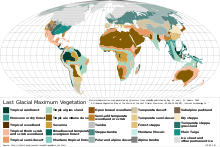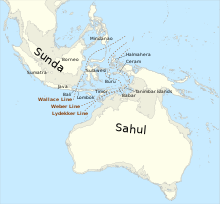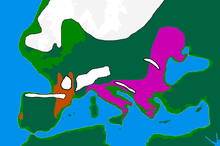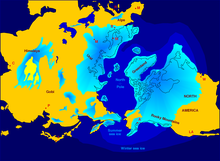Last Glacial Maximum

The Last Glacial Maximum (LGM), also referred to as the Last Glacial Coldest Period,
Based on changes in position of ice sheet margins dated via terrestrial cosmogenic nuclides and radiocarbon dating, growth of ice sheets in the southern hemisphere commenced 33,000 years ago and maximum coverage has been estimated to have occurred sometime between 26,500 years ago[1] and 20,000 years ago.[5] After this, deglaciation caused an abrupt rise in sea level. Decline of the West Antarctica ice sheet occurred between 14,000 and 15,000 years ago, consistent with evidence for another abrupt rise in the sea level about 14,500 years ago.[6][7] Glacier fluctuations around the Strait of Magellan suggest the peak in glacial surface area was constrained to between 25,200 and 23,100 years ago.[8]
There are no agreed dates for the beginning and end of the LGM, and researchers select dates depending on their criteria and the data set consulted. Jennifer French, an archeologist specialising in the European Palaeolithic, dates its onset at 27,500 years ago, with ice sheets at their maximum by around 26,000 years ago and deglaciation commencing between 20,000 and 19,000 years ago.
Glacial climate


The average global temperature about 21,000 years ago was about 6 °C (11 °F) colder than today.[12][13][14]
According to the United States Geological Survey (USGS), permanent summer ice covered about 8% of Earth's surface and 25% of the land area during the last glacial maximum.[15] The USGS also states that sea level was about 125 meters (410 ft) lower than in present times (2012).[15]
When comparing to the present, the average global temperature was 15 °C (59 °F) for the 2013–2017 period.[16] As of 2012 about 3.1% of Earth's surface and 10.7% of the land area is covered in year-round ice.[15]
Carbon sequestration in the highly stratified and productive Southern Ocean was essential in producing the LGM.
All over the world, climates at the Last Glacial Maximum were cooler and almost everywhere drier. In extreme cases, such as South Australia and the Sahel, rainfall could have been diminished by up to 90% compared to the present, with flora diminished to almost the same degree as in glaciated areas of Europe and North America. Even in less affected regions, rainforest cover was greatly diminished, especially in West Africa where a few refugia were surrounded by tropical grasslands.
The
Most of the world's deserts expanded. Exceptions were in what is the present-day Western United States, where changes in the jet stream brought heavy rain to areas that are now desert and large pluvial lakes formed, the best known being Lake Bonneville in Utah. This also occurred in Afghanistan and Iran, where a major lake formed in the Dasht-e Kavir.
In
In the period before the LGM, many areas that became completely barren desert were wetter than they are today, notably in southern Australia, where Aboriginal occupation is believed to coincide with a wet period between 40,000 and 60,000 years Before Present (BP, a formal measurement of uncalibrated radiocarbon years, counted from 1950).
In New Zealand and neighbouring regions of the Pacific, temperatures may have been further depressed during part of the LGM by the world's most recent supervolcanic eruption, the Oruanui eruption, approximately 25,500 years BP.[18]
However, it is estimated that during the LGM, low-to-mid latitude land surfaces at low elevation cooled on average by 5.8 °C relative to their present-day temperatures, based on an analysis of noble gases dissolved in groundwater rather than examinations of species abundances that have been used in the past.[19]
World impact
During the Last Glacial Maximum, much of the world was cold, dry, and inhospitable, with frequent storms and a dust-laden atmosphere. The dustiness of the atmosphere is a prominent feature in ice cores; dust levels were as much as 20 to 25 times greater than they are in the present. This was probably due to a number of factors: reduced vegetation, stronger global winds, and less precipitation to clear dust from
Africa and the Middle East
In Africa and the Middle East, many smaller mountain glaciers formed, and the Sahara and other sandy deserts were greatly expanded in extent.[21] The Atlantic deep sea sediment core V22-196, extracted off the coast of Senegal, shows a major southward expansion of the Sahara.[25]
The
It is estimated that annual average temperatures in Southern Africa were 6 °C lower than at present during the Last Glacial Maximum. This temperature drop alone would however not have been enough to generate widespread glaciation or permafrost in the Drakensberg Mountains or the Lesotho Highlands.[27] Seasonal freezing of the ground in the Lesotho Highlands might have reached depths of 2 meter or more below the surface.[28] A few small glaciers did however develop during the LGM, in particular in south-facing slopes.[27] In the Hex River Mountains, in the Western Cape, block streams and terraces found near the summit of Matroosberg evidences past periglacial activity which likely occurred during the LGM.[29] Palaeoclimatological proxies indicate the region around Boomplaas Cave was wetter, with increased winter precipitation.[30] The region of the Zambezi River catchment was colder relative to present and the local drop in mean temperature was seasonally uniform.[31]
On the island of
Asia

There were ice sheets in modern
The environment along the coast of South China was not very different from that of the present day, featuring moist subtropical evergreen forests, despite sea levels in the South China Sea being about 100 metres lower than the present day.[34]
Australasia
The Australian mainland,
Between Sahul and Sundaland – a peninsula of South East Asia that comprised present-day Malaysia and western and northern Indonesia – there remained an archipelago of islands known as Wallacea. The water gaps between these islands, Sahul and Sundaland were considerably narrower and fewer in number than in the present day.
The two main islands of New Zealand, along with associated smaller islands, were joined as one landmass. Virtually all of the Southern Alps were under permanent ice cover, with alpine glaciers extending from them into much of the surrounding high country.[35]
Europe

Northern Europe was largely covered by ice, with the southern boundary of the ice sheets passing through Germany and Poland. This ice extended northward to cover Svalbard and Franz Josef Land and northeastward to occupy the Barents Sea, the Kara Sea, and Novaya Zemlya, ending at the Taymyr Peninsula in what is now northwestern Siberia.[37] Warming commenced in northern latitudes around 20,000 years ago, but it was limited and considerable warming did not take place until around 14,600 year ago.[38]
In northwestern
Permafrost covered Europe south of the ice sheet down to as far south as present-day Szeged in Southern Hungary. Ice covered the whole of Iceland.[41] In addition, ice covered Ireland along with roughly the northern half of the British Isles with the southern boundary of the ice sheet running approximately from the south of Wales to the north east of England, and then across the now submerged land of Doggerland to Denmark.[42] Central Europe had isolated pockets of relative warmth corresponding to hydrothermally active areas, which served as refugia for taxa not adapted to extremely cold climates.[43]
In the Cantabrian Mountains of the northwestern corner of the Iberian Peninsula, which in the present day have no permanent glaciers, the LGM led to a local glacial recession as a result of increased aridity caused by the growth of other ice sheets farther to the east and north, which drastically limited annual snowfall over the mountains of northwestern Spain. The Cantabrian alpine glaciers had previously expanded between approximately 60,000 and 40,000 years ago during a local glacial maximum in the region.[44]
In northeastern
In the
Megafaunal abundance in Europe peaked around 27,000 and 21,000 BP; this bountifulness was attributable to the cold stadial climate.[48]
North America

In Greenland, the difference between LGM temperatures and present temperatures was twice as great during winter as during summer. Greenhouse gas and insolation forcings dominated temperature changes in northern Greenland, whereas Atlantic meridional overturning circulation (AMOC) variability was the dominant influence on southern Greenland's climate.[49] Illorsuit Island was exclusively covered by cold-based glaciers.[50]
Following a preceding period of relative retreat from 52,000 to 40,000 years ago,
In southeastern North America, between the southern Appalachian Mountains and the Atlantic Ocean, there was an enclave of unusually warm climate.[60]
South America
In the Southern Hemisphere, the Patagonian Ice Sheet covered the whole southern third of Chile and adjacent areas of Argentina. On the western side of the Andes the ice sheet reached sea level as far north as in the 41 degrees south at Chacao Channel.[citation needed] The western coast of Patagonia was largely glaciated, but some authors have pointed out the possible existence of ice-free refugia for some plant species. On the eastern side of the Andes, glacier lobes occupied the depressions of Seno Skyring, Seno Otway, Inútil Bay, and Beagle Channel. On the Straits of Magellan, ice reached as far as Segunda Angostura.[61]

During the LGM,
Despite glacier advances much of the area west of Llanquihue Lake was still ice-free during the Last Glacial Maximum.[64][65] During the coldest period of the Last Glacial Maximum vegetation at this location was dominated by Alpine herbs in wide open surfaces. The global warming that followed caused a slow change in vegetation towards a sparsely distributed vegetation dominated by Nothofagus species.[64][65] Within this parkland vegetation Magellanic moorland alternated with Nothofagus forest, and as warming progressed even warm-climate trees began to grow in the area. It is estimated that the tree line was depressed about 1,000 m relative to present day elevations during the coldest period, but it rose gradually until 19,300 years ago. At that time a cold reversal caused a replacement of much of the arboreal vegetation with Magellanic moorland and Alpine species.[65]
Little is known about the extent of glaciers during Last Glacial Maximum north of the Chilean Lake District. To the north, in the dry Andes of Central and the Last Glacial Maximum is associated with increased humidity and the verified advance of at least some mountain glaciers.[66] In northwestern Argentina, pollen deposits record the altitudinal descent of the treeline during the LGM.[67]
Atlantic Ocean
AMOC was weaker and more shallow during the LGM.[71] Sea surface temperatures in the western subtropical gyre of the North Atlantic were around 5 °C colder compared to today. Intermediate depth waters of the North Atlantic were better ventilated during the LGM by Glacial North Atlantic Intermediate Water (GNAIW) relative to its present-day ventilation by upper North Atlantic Deep Water (NADW). GNAIW was nutrient poor compared to present day upper NADW. Below GNAIW, southern source bottom water that was very rich in nutrients filled the deep North Atlantic.[72]
Due to the presence of immense ice sheets in Europe and North America, continental weathering flux into the North Atlantic was reduced, as measured by the increased proportion of radiogenic isotopes in neodymium isotope ratios.[73]
There is controversy whether upwelling off the Moroccan coast was stronger during the LGM compared to today. Though coccolith size increases in Calcidiscus leptoporus suggest stronger trade winds during the LGM caused there to be increased coastal upwelling of the northwestern coast of Africa,[74] planktonic foraminiferal δ13C records show upwelling and primary productivity were not enhanced during the LGM except in transient intervals around 23,200 and 22,300 BP.[75]
In the western
Pacific Ocean
On the
Low sea surface temperature (SST) and sea surface salinity (SSS) in the East China Sea during the LGM suggests the Kuroshio Current was reduced in strength relative to the present.[78] Abyssal Pacific overturning was weaker during the LGM than in the present day, although it was temporarily stronger during some intervals of ice sheet retreat.[79] The El Niño–Southern Oscillation (ENSO) was strong during the LGM.[80] Evidence suggests that the Peruvian Oxygen Minimum Zone in the eastern Pacific was weaker than it is in the present day, likely as a result of increased oxygen concentrations in seawater permitted by cooler ocean water temperatures, though it was similar in spatial extent.[81]
The outflow of North Pacific Intermediate Water through the Tasman Sea was stronger during the LGM.[82]
In the Great Barrier Reef along the coast of Queensland, reef development shifted seaward due to the precipitous drop in sea levels, reaching a maximum distance from the present coastline as sea levels approached their lowest levels around 20,700-20,500 years ago.[83]
Indian Ocean
The deep waters of the Indian Ocean were significantly less oxygenated during the LGM compared to the Middle Holocene.[84] The deep South Indian Ocean in particular was an enormous carbon sink, partially explaining the very low pCO2 of the LGM.[85] The intermediate waters of the southeastern Arabian Sea were poorly ventilated relative to today because of the weakened thermohaline circulation.[86]
Southern Ocean
Evidence from sediment cores in the Scotia Sea suggests the Antarctic Circumpolar Current was weaker during the LGM than during the Holocene.[87] The Antarctic Polar Front (APF) was located much farther to the north compared to its present-day location. Studies suggest it could have been placed as far north as 43°S, reaching into the southern Indian Ocean.[88]
Late Glacial Period
The Late Glacial Period followed the LGM and preceded the Holocene, which started around 11,700 years ago.[89]
See also
- Climate: Long range Investigation, Mapping, and Prediction
- Penultimate Glacial Period – Glacial age that occurred before the Last Glacial Period
- Mousterian Pluvial – Obsolete term for a prehistoric wet and rainy period in North Africa
- Holocene glacial retreat – Global deglaciation starting about 19,000 years ago and accelerating about 15,000 years ago
- Oldest Dryas – Abrupt climatic cooling event during the last glacial retreat
- Older Dryas – Geological period of the Earth
- Bølling–Allerød warming– Interglacial period about 14,000 years ago
- Bølling oscillation
- Allerød oscillation
- Younger Dryas – Time period c. 12,900–11,700 years ago with Northern Hemisphere glacial cooling and SH warming
- African humid period – Holocene climate period during which northern Africa was wetter than today
- 8.2-kiloyear event – Rapid global cooling around 8,200 years ago
- 5.9 kiloyear event– North Atlantic ice rafting events
- 4.2-kiloyear event – Severe climatic event starting around 2200 BC
- Older Peron – Global sea-level high-stand during the Holocene Epoch
- Piora Oscillation – Abrupt cold and wet period in the Holocene Epoch
- Little Ice Age – Climatic cooling after the Medieval Warm Period (16th–19th centuries)
- Sea level rise – Rise in sea levels due to climate change
- Black Sea deluge hypothesis – Hypothetical flood scenario
- Timeline of glaciation – Chronology of the major ice ages of the Earth
Notes
- ^ . Retrieved 9 May 2023.
- PMID 31700065.
- PMID 32665576.
- ISBN 978-0-674-01570-8.
- . Retrieved 10 May 2023.
- S2CID 1324559.
- ISBN 978-1-46149635-9– via Google books.
- S2CID 216352827. Retrieved 5 November 2022.
- ISBN 978-1-108-49206-5.
- ISBN 978-0-00-815035-8.
- ISBN 978-0415674546.
- ^ "How cold was the ice age? Researchers now know". phys.org. Retrieved 7 September 2020.
- S2CID 221346116. Retrieved 7 September 2020.
- ISSN 1476-4687.
- ^ a b c Richard Z. Poore, Richard S. Williams, Jr., and Christopher Tracey. "Sea Level and Climate". United States Geological Survey.
- ^ "Land and Ocean Summary". Berkeley Earth.
- S2CID 259377398. Retrieved 21 September 2023.
- ISSN 0033-8222.
- S2CID 234485970.
- ^ Cowen, Robert C. "Dust Plays a Huge Role in Climate Change" Christian Science Monitor 3 April 2008 ("Dust plays huge role in climate change". Christian Science Monitor. 2008-04-03. Archived from the original on 2013-09-28. Retrieved 2012-09-21.), and Claquin et al., "Radiative Forcing of Climate by Ice-Age Atmospheric Dust", Climate Dynamics (2003) 20: 193–202. (www.rem.sfu.ca/COPElab/Claquinetal2003_CD_glacialdustRF.pdf)
- ^ a b Mithen 2004
- ^ "Glaciers and Sea Level". U.S. Geological Survey. U.S. Geological Survey, U.S. Department of the Interior. 30 May 2012. Archived from the original on 4 January 2017. Retrieved 4 January 2017.
- S2CID 4366756. Retrieved 21 September 2023.
- ISSN 2197-4284.
- S2CID 129021250. Retrieved 17 September 2023.
- ^ "Marine Geophysics". QNHER, Qatar Archaeology. Archived from the original on 2014-12-20.
- ^ hdl:10026.1/8086.
- S2CID 128637011.
- .
- . Retrieved 12 April 2024 – via Elsevier Science Direct.
- ISSN 0012-821X. Retrieved 5 January 2024 – via Elsevier Science Direct.
- S2CID 55382331. Retrieved 28 April 2023.
- ^ Sathiamurthy, E.; Voris, H.K. (2006). "Pleistocene Sea Level Maps for the Sunda Shelf". Chicago IL: The Field Museum. Archived from the original on 2009-03-17.
- . Retrieved 15 April 2023.
- ISBN 1-86953-408-5
- PMID 36859578.
- doi:10.1016/j.quascirev.2003.12.009. Archived from the original(PDF) on 2012-07-13.
- ^ French, Palaeolithic Europe, p. 234
- .
- . Retrieved 9 June 2024 – via Elsevier Science Direct.
- ^ "Internet Archaeology 11: Ray & Adams 4.5 Europe". intarch.ac.uk. Archived from the original on 2016-10-13. Retrieved 2018-02-05.
- ^ Curry, Andrew (30 January 2020). "Lost world revealed by human, Neanderthal relics washed up on North Sea beaches". American Association for the Advancement of Science. Retrieved 3 February 2020.
- PMID 38820152. Retrieved 9 June 2024.
- . Retrieved 15 November 2022.
- PMID 33093492.
- ^ Kuhlemann, J.; Milivojević, M.; Krumrei, Ingrid; Kubik, P. W. (January 2009). "Last glaciation of the Šara Range (Balkan peninsula): Increasing dryness from the LGM to the Holocene". Austrian Journal of Earth Sciences. 102 (1): 146–158. Retrieved 24 September 2023.
- PMID 36966144.
- PMID 36414639.
- S2CID 6002922. Retrieved 21 September 2023.
- S2CID 54030327. Retrieved 21 September 2023.
- S2CID 133703425. Retrieved 22 November 2022.
- S2CID 135332612.
- S2CID 53982009.
- S2CID 4408645. Retrieved 22 November 2022.
- . Retrieved 25 November 2022.
- JSTOR 40508876.
- doi:10.1080/00040851.1977.12003898 (inactive 31 January 2024). Retrieved 22 November 2022.)
{{cite journal}}: CS1 maint: DOI inactive as of January 2024 (link - PMID 30185871.
- PMID 20587512.
- ISSN 1464-7931. Retrieved 9 June 2024 – via Wiley Online Library.
- hdl:11336/86869.
- ^ Heusser, C.J. (2004). Ice Age Southern Andes. pp. 25–29.
- S2CID 128632559.
- ^ S2CID 13594891.
- ^ hdl:10533/148448.
- ^ Harrison, Stephan (2004). "The Pleistocene glaciations of Chile". In Ehlers, J.; Gibbard, P.L. (eds.). Quaternary Glaciations – Extent and Chronology: Part III: South America, Asia, Africa, Australasia, Antarctica. pp. 91–97.
- S2CID 135184342. Retrieved 10 January 2023.
- ISSN 1040-6182. Retrieved 19 December 2023.
- ISSN 0012-821X. Retrieved 19 December 2023.
- ISSN 0895-9811. Retrieved 5 January 2024 – via Elsevier Science Direct.
- PMID 37064010.
- hdl:1912/3433.
- S2CID 246589455.
- ^ Henderiks, Jorijntje; Renaud, Sabrina (2004). "Coccolith size increase of Calcidiscus leptoporus offshore Morocco during the Last Glacial Maximum: an expression of enhanced glacial productivity?" (PDF). Journal of Nannoplankton Research. 26 (1): 1–12. Retrieved 13 April 2024.
- . Retrieved 11 April 2024 – via Elsevier Science Direct.
- S2CID 210275032. Retrieved 15 May 2023.
- ^ "Mauna Kea Hawai'i's Tallest Volcano". USGS. Archived from the original on 2009-05-08.
- ISSN 1814-9332. Retrieved 2 October 2023.
- S2CID 134294675. Retrieved 8 January 2023.
- .
- S2CID 254222480.
- PMID 35773248.
- S2CID 134502712. Retrieved 21 April 2023.
- PMID 37563128. Retrieved 19 December 2023.
- PMID 33273459. Retrieved 5 January 2024.
- S2CID 234090602. Retrieved 17 September 2023.
- S2CID 224927165. Retrieved 4 December 2022.
- S2CID 155368892. Retrieved 31 December 2023 – via Elsevier Science Direct.
- ^ Stone, P.; et al. "Late glacial period, Quaternary, Northern England". Earthwise. British Geological Survey.
Further reading
- Developments in Quaternary Science Series
- Gillespie, Alan R.; Porter, Stephen C.; Atwater, Brian F. (2003). The Quaternary Period in the United States. Elsevier. ISBN 978-0-444-51471-4.
- Ehlers, Jürgen; Gibbard, Philip L. (2004). Quaternary Glaciations Extent and Chronology. 1. Europe. Elsevier. ISBN 978-0-444-51462-2.
- Ehlers, Jürgen; Gibbard, Philip L. (2004). Quaternary Glaciations: Extent and Chronology. 2. North America. Elsevier. ISBN 978-0-444-51592-6.
- Ehlers, Jürgen; Gibbard, Philip L. (2004). Quaternary Glaciations: Extent and Chronology. 3. South America, Asia, Africa, Australia, Antarctica. Elsevier. ISBN 978-0-444-51593-3.
- Gillespie, Alan R.; Porter, Stephen C.; Atwater, Brian F. (2003). The Quaternary Period in the United States. Elsevier.
- Šibrava, Vladimír (1986). Šibrava, V.; Bowen, D.Q; Richmond, G.M. (eds.). "Quaternary Glaciations in the Northern Hemisphere". Quaternary Science Reviews. 5: 1–514. .
External links
- Adams, J.M. (1997). "Global land environments since the last interglacial". Atlas of Palaeovegetation: Preliminary land ecosystem maps of the world since the Last Glacial Maximum. Oak Ridge National Laboratory, TN. Archived from the original on 2008-01-16.
- "Map and GIS database of glacial landforms and features related to the last British Ice Sheet". BRITICE. Department of Geology, University of Sheffield. 2004.
- Dyke, A.S.; Moore, A.; Robertson, L. (2003). "Deglaciation of North America". Geological Survey of Canada Open File, 1574. (32 digital maps at 1:7 000 000 scale with accompanying digital chronological database and one poster (two sheets) with full map series.)
- Manley, W.; Kuaffman, D. "Alaska PaleoGlacier Atlas: A Geospatial Compilation of Pleistocene Glacier Extents". INSTAAR. University of Colorado.
- Paleoclimate Modelling Intercomparison Project (PMIP) PMIP Web Site and 'Publications : Last Glacial Maximum.
- Paleoclimate Modelling Intercomparison Project Phase II (PMIP2) PMIP2 Home page and PMIP 2 Publications.
- Osipov, Eduard Y.; Khlystov, Oleg M. "Glaciers and meltwater flux to Lake Baikal during the Last Glacial Maximum".
